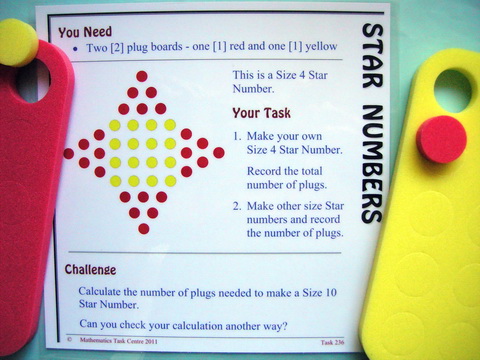
Star NumbersTask 236 ... Years 2 - 10SummaryThis highly visual and tactile method of creating a star shape suggests number patterns right from the start. The number patterns can be extended and generalised and even written in symbolic form. Further, by linking the size of the star to the number of plugs to make ordered pairs, the door opens to exploring non-linear graphs.The From The Classroom contribution to this cameo is a fabulous Year 9 student report. Even if you don't understand Swedish, you will understand the mathematics and that Helena is, very clearly, working like a mathematician. |
Materials
Content
|

IcebergA task is the tip of a learning iceberg. There is always more to a task than is recorded on the card. |
Firstly we have to thank Per Berggren, Trägardsstadskolan, Stockholm for introducing this task to our collection - and for introducing it to his Year 9 class. As Helena's report shows (see the link below), the pattern can be quite absorbing. Helena reports that she was so intrigued, she wrote about her struggle on Facebook during the weekend she was exploring the challenge. It's not unreasonable to tackle this problem using a make and count technique. In fact, it is very attractive to do so, even for adults, as evidenced by these photos from a class of teachers in training for senior years of high school at Högskolan Malmö, Sweden. |

|

|

|
 Some were also prepared to make the Size 10 to answer the question on the card. Some were also prepared to make the Size 10 to answer the question on the card.
In the meantime colleagues were building a table of results and everyone is recognising a square number and 4 lots of the triangle number one size smaller. So one way to generalise is: Pn = n2 + 4 x T(n-1)Although such generalisation and symbolism is possible, it doesn't mean the problem is out of reach of younger children. Perhaps they don't know what a square number is, but they are very likely to recognise the multiplication array at the centre of the star. They are also likely to see the red triangle component as the sum of counting numbers, so each triangle for Size 10 would be: 1 + 2 + 3 + 4 + 5 + 6 + 7 + 8 + 9  Some may also recognise pairing which makes calculation easier, such as: Some may also recognise pairing which makes calculation easier, such as:
(1 + 9) + (2 + 8) + (3 + 7) + (4 + 6) + 5 = (4 x 10) + 5 = 45So, P10 = 102 + 4 x 45 = 100 + 180 = 280. But the challenge is about seeing the construction another way. For example, two of the red triangles placed on top of the square starting from diagonally opposite corners would leave an uncovered line of yellow plugs along the other diagonal. So two of the red triangles counts the same as another square ... less a diagonal, which is, of course, the same number of plugs as the side of the square. This could be done again with the other pair of red triangles. So the total is 3 squares less 2 diagonals: Pn = 3n2 - 2nChecking this for Size 10 gives: P10 = 3 x 102 - (2 x 10) = 300 - 20 = 280and using the mathematician's question Can I check it another way? means that we don't have to ask if we are correct. How many other ways can you find to see the construction and derive an equivalent algebraic expression? Extensions
|

|

|

|

|
It's nice to see that the technology confirms what the mind and hand can 'see' so simply. | 
|
Whole Class InvestigationTasks are an invitation for two students to work like a mathematician. Tasks can also be modified to become whole class investigations which model how a mathematician works. |
You could use counters to build a whole class investigation of Star Numbers, but Poly Plug is simply better for this activity. See Poly Plug & Tasks for more information. Perhaps you will discover another Helena in your Year 9. You are invited to explore Helena's Stjärnor Report. This is a PDF slide show written in Mathematics and Swedish. Use arrow keys to move through the show. Even if you don't understand a word of the report, you will recognise a mathematician at work. You will also meet Helena in the last slide. |
Is it in Maths With Attitude?Maths With Attitude is a set of hands-on learning kits available from Years 3-10 which structure the use of tasks and whole class investigations into a week by week planner. |
Star Numbers is not in any MWA kit. However it can be used to enrich the Number & Computation kit at Years 5/6 and the Pattern & Algebra kit at Years 9/10. |